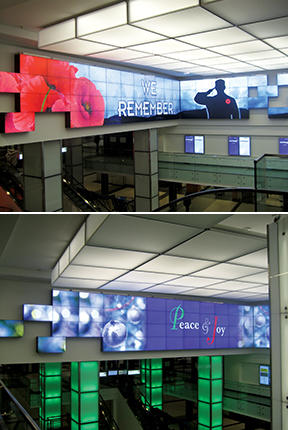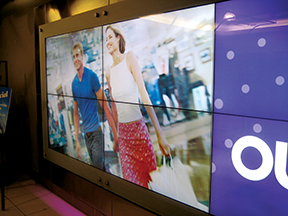By Peter Saunders
When RioCan, reportedly the largest real estate investment trust (REIT) in Canada, began to renovate and expand Toronto’s Yonge Eglinton Centre, it took advantage of the opportunity to include digital signage in the plans from day one, working with local firm Kramer Design Associates (KDA) to ensure the technology would become an integral part of the mixed-use facility’s future.
At press time, PCL Construction is still finishing the $65-million redevelopment of the property on the busy northwest corner of Yonge Street and Eglinton Avenue, which sees combined vehicular and pedestrian traffic volumes top 128,000 daily, reportedly making it Toronto’s second busiest intersection. These numbers are only expected to rise as the affluent neighbourhood adds more high-rise condominium towers and a new Eglinton cross-town light-rail transit (LRT) line intersects with the existing Yonge subway line. Indeed, growth is outpacing the city’s average.
With this audience in mind, the renovated Yonge Eglinton Centre is integrating 75 digital signage deployments of various sizes.
Specifying screens
Most of these units are indoors, where they can display both static and full-motion content to an estimated 30,000 shoppers in the mall and 70,000 subway passengers every day. Their screen sizes range from 0.8 m (32 in.) and 1.2 m (46 in.) in
the food court to 1.4 m (55 in.) throughout most of the mall to 1.8 m (70 in.) for some vertically oriented placements.
The major showcase feature of the internal digital signage network is a centre court ‘panorama,’ where 72 narrow-bezel 1.4-m liquid crystal displays (LCDs) from Nanov Display form unique video walls along the east and north sides of the mall’s main atrium. Following a series of construction delays, these video walls were installed and integrated in September 2014 by A-Tec Signs and Service, based in Brampton, Ont.
“These screens can be opened from the front for maintenance,” says Myung Kune Moon, executive vice-president (EVP) of Nanov. “This has already come in handy, as some High-Definition Multimedia Interface (HDMI) cables were damaged and had to be replaced.”

The major showcase feature of the indoor network is a centre court ‘panorama,’ where 72 narrow-bezel LCDs form unique video walls along the east and north sides of the main atrium.
Managing content
On June 10, 2014, RioCan announced out-of-home (OOH) advertising firm CBS Outdoor Canada had won the bid to operate the Yonge Eglinton Centre’s digital signage assets, effective August 1. In return, CBS would return a certain amount of ad revenue to RioCan.
As it turned out, by the time the first phase of the network—comprising 21 new and nine pre-existing indoor screens—went live in November, CBS Outdoor had been spun off as its own business and rebranded Outfront Media.
“Our rebrand was announced on October 20,” says Jacqueline Demchuk, sales marketing manager for Outfront Media Canada. “One month later, on November 20, we officially changed over on the New York Stock Exchange (NYSE) from ‘CBS’ to ‘OUT.’ Over the next few months, we will continue to change the imprints on all of our OOH signs.”
Like other Outfront-managed facilities across North America, the Yonge-Eglinton Centre’s digital signage network uses content management software developed by Omnivex in Concord, Ont. This is allowing advertisers’ campaigns to target certain screens or be broadly displayed throughout the building.
“This is an uncluttered environment, where you’re not fighting for space with any other digital OOH (DOOH) network,” says Michele Erskine, director of marketing for Outfront Media Canada. “It’s not just a mall, it’s a true hub for the neighbourhood, linking people to offices, transit, cinemas and other services. A lot of people move through here several times every day, not just once in a while to shop.”
A phased launch
Still to come are two exterior corner-wrapping 4.3 x 14.6-m (14 x 48-ft) light-emitting diode (LED) boards from Mitsubishi, which will face the aforementioned vehicular and pedestrian traffic and provide a dynamic backdrop to a new courtyard space. They will be part of the network’s second phase, which will also see 38 more indoor screens—including
15 existing installations and 23 new ones—join
the network.
“We were conservative in our approach to phase one,” says Outfront’s Erskine. “Phase two will be the bigger launch. The two exterior boards are what originally drew us to this facility, but we can do so much more indoors, particularly because we’re not restricted to static content there. Content on the video walls, for example, can tie in with ‘product activations’ and other events in the atrium. A campaign can dominate here in a non-intrusive way.”
With files from Nanov Display and Outfront Media Canada. For more information, visit www.nanovdisplay.com and www.outfrontmedia.ca.






